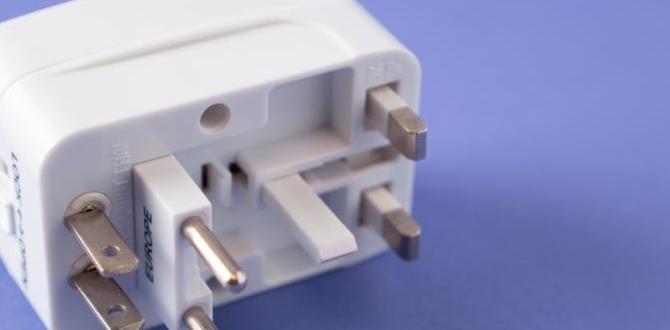Have you ever tried to start your car, only to find out the battery is dead? That can be a real hassle! Sometimes, the problem isn’t the battery itself. Instead, it might be parasitic battery drain. This can happen when something in your car keeps using power even when it’s off.
Imagine you parked your car after a long day. You lock it up, but a light is left on inside. This little light can slowly drain your battery. You might not even notice it until the next morning. Wouldn’t it be great to know how to test for parasitic battery drain? Understanding how to do this can save you time and money.
In this article, we will help you uncover ways to find out if there’s a hidden battery thief in your vehicle. Testing for parasitic battery drain isn’t as tricky as it sounds. You just need to know the right steps to follow. Let’s dive in and learn together!
How To Test For Parasitic Battery Drain Effectively

How to Test for Parasitic Battery Drain
Testing for parasitic battery drain can save you from unexpected battery failures. To start, you need a multimeter to measure current draw. Disconnect the negative battery cable and connect the meter between the battery and the cable. If the reading exceeds 50 milliamps, you likely have a drain. Check each fuse in your car to find the source. Did you know that even a small light bulb left on can drain your battery? Being proactive can help you avoid a dead battery in the morning!Understanding Parasitic Battery Drain
Definition of parasitic battery drain. Common causes of parasitic drain in vehicles.Imagine your car battery like a sleeping bear. Sometimes, it needs its beauty sleep, but if something wakes it up, it drains energy. This sneaky energy loss is what we call parasitic battery drain. Common culprits include lights left on, faulty wiring, or even a radio that won’t stop playing your favorite tunes. These issues gradually drain the battery, much like a hamster on a wheel—lots of effort but no real progress!
| Causes of Parasitic Drain | Description |
|---|---|
| Lights Left On | Interior or exterior lights that are not turned off. |
| Faulty Wiring | Wires that are damaged or short-circuited. |
| Malfunctioning Accessories | Things like alarm systems or radios that stay active. |
Signs of Parasitic Battery Drain
Symptoms indicating battery issues. How to identify a battery that is draining too quickly.Many people don’t realize their car battery is losing power. Some common signs include:
- Car won’t start or takes longer to start
- Lights are dim or flicker
- Power features, like windows or locks, work slowly
- Warning lights on the dashboard stay lit
If you notice these signs, your battery might be draining too quickly. Keep an eye on how often you need to jump-start it. Regular check-ups can help prevent bigger problems.
What should I look for to know my battery is having trouble?
Look for signs like a slow-starting engine or dim lights. Also, note if it frequently needs a jump-start. These are indications of a weak battery.
Tools and Equipment Needed
List of essential tools for testing. Recommended multimeters and their features.Testing for battery drain can be fun! To get started, you need a few must-have tools. First, you’ll need a good multimeter. This device measures voltage and current, helping you find hidden battery gobblers. Look for ones with a digital display and features like auto-ranging.
| Multimeter Model | Key Features |
|---|---|
| Fluke 117 | True RMS, backlit display |
| Extech EX330 | Auto-ranging, temperature feature |
Don’t forget about a battery load tester, which shows how well your battery holds up under pressure. And, of course, you’ll need basic tools like screwdrivers and wires. With these, you’re set for a test! It’s like preparing for a battery detective mission—caped crusaders of the car world!
Step-by-Step Testing Procedure
Detailed steps to perform a parasitic drain test. Setting up the multimeter correctly.Testing for parasitic battery drain can feel like a puzzle. Follow these steps, and you’ll be the detective solving the mystery! First, gather your tools: a car battery and a multimeter. Set the multimeter to measure amps. Now, disconnect the negative battery cable. Connect the multimeter between the battery terminal and the cable. This way, you will read the draw from the vehicle. Finally, check your reading. If it’s over 50 milliamps, you might have a leak! Time to investigate.
| Step | Action |
|---|---|
| 1 | Gather tools (multimeter, battery) |
| 2 | Set multimeter to amps |
| 3 | Disconnect negative battery cable |
| 4 | Connect multimeter leads |
| 5 | Check your reading |
Interpreting the Test Results
How to read the multimeter results. What constitutes normal vs. excessive drain values.Reading the multimeter results can feel like interpreting ancient hieroglyphics, but it’s easier than you think! First, normal battery drain is usually below 50 milliamps. Anything above that might make your wallet cry. Use the table below for quick guidance:
| Drain Value (mA) | Description |
|---|---|
| 0 – 50 | Normal drain – The car is happy! |
| 50 – 100 | Moderate drain – Time to check the lights! |
| 100+ | Excessive drain – Call for help! |
So, if your reading is over 100 mA, your battery is throwing a tantrum. Investigate before it becomes a bigger problem. Remember, a happy battery is a long-lasting battery!
Solving Parasitic Drain Issues
Troubleshooting tips based on identified sources. Repair or replacement options for problematic components.Finding the pesky source of battery drain can feel like a mystery novel. First, check your car lights. Did you leave a door ajar or a light on? It happens! Next, locate any electrical gadgets that might be draining juice. Sometimes, old parts can cause trouble. Look closely at your battery, wires, and fuses—the usual suspects. If you spot damage, replacing faulty parts might be the answer. If all else fails, consult a mechanic. They’re like detectives for your car’s woes!
| Component | Action |
|---|---|
| Battery | Check for corrosion or leaks; replace if damaged |
| Wires | Inspect for wear; fix or replace as needed |
| Fuses | Test for functionality; replace blown fuses |
Remember, sometimes the easiest fixes are the most overlooked! A little detective work can save your battery.
Preventive Measures
Strategies to avoid future battery drain. Maintenance tips for battery longevity.Taking care of your car battery can prevent future issues. Simple strategies can help keep it healthy. Regular maintenance checks are essential for battery longevity. Make sure to:
- Clean battery terminals from corrosion.
- Check connections for tightness.
- Test the battery’s health yearly.
- Avoid leaving lights or electronics on.
- Limit short trips; they don’t fully charge the battery.
Following these tips can help you avoid battery drain and keep your car running smoothly.
What is a good way to ensure battery health?
Regularly testing and maintaining your battery is key to maintaining its health. Always check for corrosion and ensure connections are tight.
FAQs about Parasitic Battery Drain
Common questions and expert answers. Clarifications on misconceptions related to battery issues.Many people have questions about battery drain issues. Understanding these can help everyone. Here are some common questions and answers:
What causes parasitic battery drain?
Parasitic battery drain happens when something in the car uses power even when it is off. This could be devices like alarms, clocks, or lights.
Can I fix parasitic drain myself?
Yes, you can check your battery and fuses on your own. But if it’s complicated, it’s good to ask a mechanic for help.
Do all cars have parasitic battery drain?
Yes, all cars have some level of parasitic drain. It’s normal but should be kept low.
Conclusion
To test for parasitic battery drain, you start with a multimeter. Disconnect your battery and connect the meter’s leads. Look for any abnormal readings. This helps identify hidden power uses. If you find one, investigate and fix it. Remember, keeping your battery healthy is crucial! For more tips, check out guides on battery maintenance next. Stay informed and keep your car running smoothly!FAQs
What Are The Common Symptoms Of Parasitic Battery Drain In A Vehicle?Common symptoms of parasitic battery drain in a vehicle include the battery dying quickly, lights not turning on, or the car not starting. You might also notice that the radio or other electronics don’t work. Sometimes, the dashboard may show weird lights or messages. If you see these signs, your battery might be using too much power when the car is off.
How Can I Identify Which Electrical Component Is Causing Parasitic Battery Drain?To find out which part is draining your battery, first, make sure everything is off in your car. Then, you need a tool called a multimeter to check the battery. Connect the multimeter in a special way to see if there’s extra power being used when everything should be off. If it shows some drain, you can unplug one part at a time until the drain stops. The last part you unplug is likely the problem!
What Tools Do I Need To Test For Parasitic Battery Drain Effectively?To test for parasitic battery drain, you need a few simple tools. First, get a multimeter, which helps measure electrical current. You will also need basic hand tools like screwdrivers to open your car’s hood. A notebook can help you write down your findings. With these tools, you can check what is using up your battery power.
What Are The Steps Involved In Performing A Parasitic Battery Drain Test?To perform a parasitic battery drain test, first, make sure the vehicle is off and all doors are closed. Next, disconnect the battery’s negative cable. Then, use a multimeter to check the current between the negative terminal and the cable. If the reading is high, check the fuses to find the problem. Finally, fix or replace the faulty parts to stop the drain.
How Can I Prevent Or Fix Parasitic Battery Drain Once It’S Been Identified?To stop or fix parasitic battery drain, first, check your car’s electrical systems. Look for lights that stay on, like trunk lights or dome lights. You can also unplug any gadgets or devices that aren’t needed. If you still have a problem, ask a mechanic for help. They can find and fix tricky issues.





